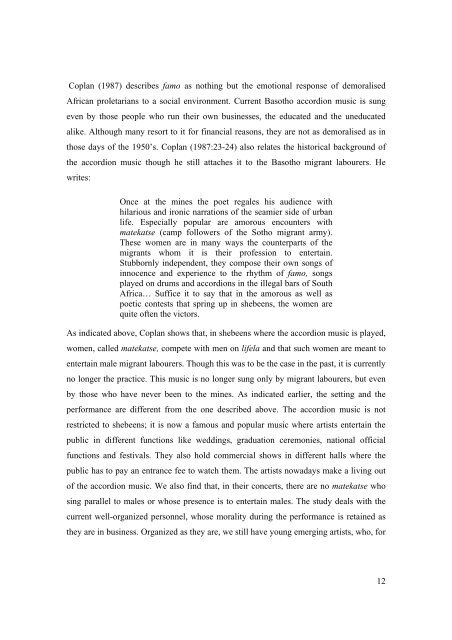Analysis of the language techniques and thematic - University of the ...
Analysis of the language techniques and thematic - University of the ...
Analysis of the language techniques and thematic - University of the ...
You also want an ePaper? Increase the reach of your titles
YUMPU automatically turns print PDFs into web optimized ePapers that Google loves.
Coplan (1987) describes famo as nothing but <strong>the</strong> emotional response <strong>of</strong> demoralised<br />
African proletarians to a social environment. Current Basotho accordion music is sung<br />
even by those people who run <strong>the</strong>ir own businesses, <strong>the</strong> educated <strong>and</strong> <strong>the</strong> uneducated<br />
alike. Although many resort to it for financial reasons, <strong>the</strong>y are not as demoralised as in<br />
those days <strong>of</strong> <strong>the</strong> 1950’s. Coplan (1987:23-24) also relates <strong>the</strong> historical background <strong>of</strong><br />
<strong>the</strong> accordion music though he still attaches it to <strong>the</strong> Basotho migrant labourers. He<br />
writes:<br />
Once at <strong>the</strong> mines <strong>the</strong> poet regales his audience with<br />
hilarious <strong>and</strong> ironic narrations <strong>of</strong> <strong>the</strong> seamier side <strong>of</strong> urban<br />
life. Especially popular are amorous encounters with<br />
matekatse (camp followers <strong>of</strong> <strong>the</strong> Sotho migrant army).<br />
These women are in many ways <strong>the</strong> counterparts <strong>of</strong> <strong>the</strong><br />
migrants whom it is <strong>the</strong>ir pr<strong>of</strong>ession to entertain.<br />
Stubbornly independent, <strong>the</strong>y compose <strong>the</strong>ir own songs <strong>of</strong><br />
innocence <strong>and</strong> experience to <strong>the</strong> rhythm <strong>of</strong> famo, songs<br />
played on drums <strong>and</strong> accordions in <strong>the</strong> illegal bars <strong>of</strong> South<br />
Africa… Suffice it to say that in <strong>the</strong> amorous as well as<br />
poetic contests that spring up in shebeens, <strong>the</strong> women are<br />
quite <strong>of</strong>ten <strong>the</strong> victors.<br />
As indicated above, Coplan shows that, in shebeens where <strong>the</strong> accordion music is played,<br />
women, called matekatse, compete with men on lifela <strong>and</strong> that such women are meant to<br />
entertain male migrant labourers. Though this was to be <strong>the</strong> case in <strong>the</strong> past, it is currently<br />
no longer <strong>the</strong> practice. This music is no longer sung only by migrant labourers, but even<br />
by those who have never been to <strong>the</strong> mines. As indicated earlier, <strong>the</strong> setting <strong>and</strong> <strong>the</strong><br />
performance are different from <strong>the</strong> one described above. The accordion music is not<br />
restricted to shebeens; it is now a famous <strong>and</strong> popular music where artists entertain <strong>the</strong><br />
public in different functions like weddings, graduation ceremonies, national <strong>of</strong>ficial<br />
functions <strong>and</strong> festivals. They also hold commercial shows in different halls where <strong>the</strong><br />
public has to pay an entrance fee to watch <strong>the</strong>m. The artists nowadays make a living out<br />
<strong>of</strong> <strong>the</strong> accordion music. We also find that, in <strong>the</strong>ir concerts, <strong>the</strong>re are no matekatse who<br />
sing parallel to males or whose presence is to entertain males. The study deals with <strong>the</strong><br />
current well-organized personnel, whose morality during <strong>the</strong> performance is retained as<br />
<strong>the</strong>y are in business. Organized as <strong>the</strong>y are, we still have young emerging artists, who, for<br />
12

















